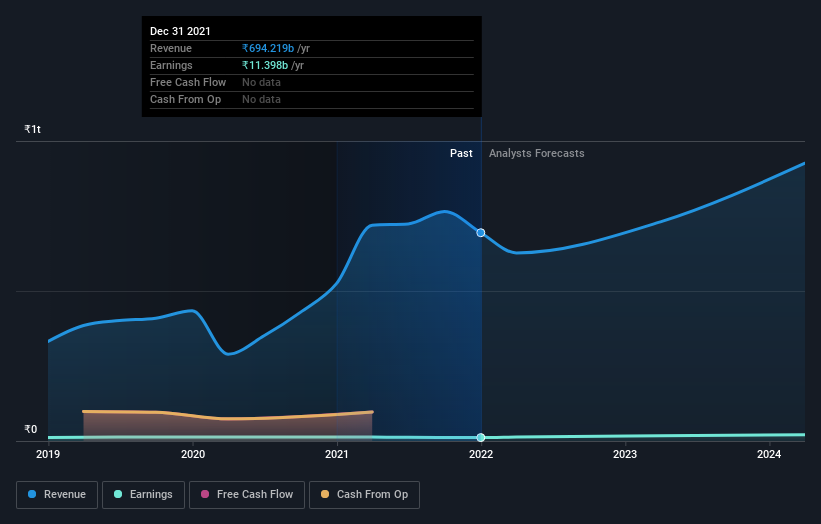Could The HDFC Life Insurance Company Limited (NSE:HDFCLIFE) Ownership Structure Tell Us Something Useful? – Simply Wall St

The big shareholder groups in HDFC Life Insurance Company Limited (NSE:HDFCLIFE) have power over the company. Generally speaking, as a company grows, institutions will increase their ownership. Conversely, insiders often decrease their ownership over time. Companies that used to be publicly owned tend to have lower insider ownership.
HDFC Life Insurance is a pretty big company. It has a market capitalization of ₹1.3t. Normally institutions would own a significant portion of a company this size. Our analysis of the ownership of the company, below, shows that institutions own shares in the company. Let’s take a closer look to see what the different types of shareholders can tell us about HDFC Life Insurance.
View our latest analysis for HDFC Life Insurance
NSEI:HDFCLIFE Ownership Breakdown January 28th 2022
What Does The Institutional Ownership Tell Us About HDFC Life Insurance?
Institutional investors commonly compare their own returns to the returns of a commonly followed index. So they generally do consider buying larger companies that are included in the relevant benchmark index.
As you can see, institutional investors have a fair amount of stake in HDFC Life Insurance. This can indicate that the company has a certain degree of credibility in the investment community. However, it is best to be wary of relying on the supposed validation that comes with institutional investors. They too, get it wrong sometimes. If multiple institutions change their view on a stock at the same time, you could see the share price drop fast. It’s therefore worth looking at HDFC Life Insurance’s earnings history below. Of course, the future is what really matters.
 NSEI:HDFCLIFE Earnings and Revenue Growth January 28th 2022
NSEI:HDFCLIFE Earnings and Revenue Growth January 28th 2022
We note that hedge funds don’t have a meaningful investment in HDFC Life Insurance. Our data shows that Housing Development Finance Corporation Limited is the largest shareholder with 48% of shares outstanding. For context, the second largest shareholder holds about 4.6% of the shares outstanding, followed by an ownership of 3.7% by the third-largest shareholder.
After doing some more digging, we found that the top 2 shareholders collectively control more than half of the company’s shares, implying that they have considerable power to influence the company’s decisions.
Researching institutional ownership is a good way to gauge and filter a stock’s expected performance. The same can be achieved by studying analyst sentiments. There are a reasonable number of analysts covering the stock, so it might be useful to find out their aggregate view on the future.
Insider Ownership Of HDFC Life Insurance
The definition of an insider can differ slightly between different countries, but members of the board of directors always count. Management ultimately answers to the board. However, it is not uncommon for managers to be executive board members, especially if they are a founder or the CEO.
Most consider insider ownership a positive because it can indicate the board is well aligned with other shareholders. However, on some occasions too much power is concentrated within this group.
Our data suggests that insiders own under 1% of HDFC Life Insurance Company Limited in their own names. As it is a large company, we’d only expect insiders to own a small percentage of it. But it’s worth noting that they own ₹5.1b worth of shares. It is good to see board members owning shares, but it might be worth checking if those insiders have been buying.
General Public Ownership
With a 22% ownership, the general public, mostly comprising of individual investors, have some degree of sway over HDFC Life Insurance. This size of ownership, while considerable, may not be enough to change company policy if the decision is not in sync with other large shareholders.
Public Company Ownership
It appears to us that public companies own 48% of HDFC Life Insurance. This may be a strategic interest and the two companies may have related business interests. It could be that they have de-merged. This holding is probably worth investigating further.
Next Steps:
While it is well worth considering the different groups that own a company, there are other factors that are even more important. To that end, you should be aware of the 4 warning signs we’ve spotted with HDFC Life Insurance .
But ultimately it is the future, not the past, that will determine how well the owners of this business will do. Therefore we think it advisable to take a look at this free report showing whether analysts are predicting a brighter future.
NB: Figures in this article are calculated using data from the last twelve months, which refer to the 12-month period ending on the last date of the month the financial statement is dated. This may not be consistent with full year annual report figures.
Have feedback on this article? Concerned about the content? Get in touch with us directly. Alternatively, email editorial-team (at) simplywallst.com.
This article by Simply Wall St is general in nature. We provide commentary based on historical data and analyst forecasts only using an unbiased methodology and our articles are not intended to be financial advice. It does not constitute a recommendation to buy or sell any stock, and does not take account of your objectives, or your financial situation. We aim to bring you long-term focused analysis driven by fundamental data. Note that our analysis may not factor in the latest price-sensitive company announcements or qualitative material. Simply Wall St has no position in any stocks mentioned.




